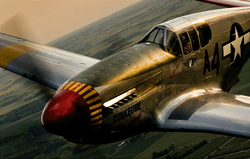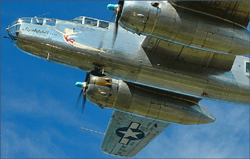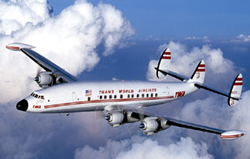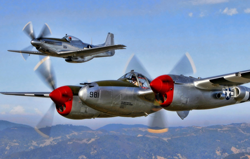Corsair

Manufacturer: Chance Vought Corporation
Primary Role: Fighter
- Description:
- Specifications:
The F4U Corsair fighters first took flight in 1940. Jointly designed by Rex Beisel and Igor Sikorsky, the fighters with inverted gull wings were designed as carrier fighters from the ground up but without sacrificing much of the capabilities. The Corsair fighters were the first American fighters to reach the speech of over 717-km/h in level flight thanks to its streamlined body design (retractable landing gears, streamlined air intakes, etc.) and they packed ample firepower which led to their usage of close ground support fighters in Pacific landing operations.
F4U Corsair fighters' complex design gave them superior performance, but it also gave the aircraft mechanics aboard carriers difficulties, particularly when the model was initially introduced. Additionally, the fighters' long noses hampered visibility during landings, causing many fatal crashes. Such growing pains caused some disliking for the model in the US Navy airmen; initially, the US Navy actually deemed Corsair aircraft unsuitable for carrier operation and assigned them to the US Marines.
While the US Navy took a more cautioned approach, the British Royal Navy Fleet Air Arm introduced the Corsair fighters first. This move was largely because while the US Navy had the proven F6F Hellcat fighters, the British existing carrier fighters were less capable. 424 Corsair fighters were also given to the British Commonwealth Forces of New Zealand. British and Commonwealth operational experiences were fed back to Chance Vought, the manufacturers of the model, while British pilots shared an alternate landing technique with the US Navy. It was then that the US navy began adopting them for carrier service. As the Japanese began operating Special Attack tactics, the now-nicknamed "Sweethearts of the Marianas" began to display their strengths as their faster speed and climb rate were much better suited for intercepting kamikaze aircraft than anything else in the Allied arsenal.
Overall, 12,500 F4U Corsair fighters of 16 separate models were built by Chance Vought, Goodyear, and Brewster. They achieved a kill:loss ratio of 10:1, and remained flight worthy to participate in the Korean War and the war in Indochina, both in the first half of the 1950s. A few Corsair fighters were also seen during the Football War between Honduras and El Salvador in 1969.
Length: 9.99 m
Height: 4.90 m
Powerplant: Pratt & Whitney R-2800-18W Double Wasp 18-cyl radial engine
Cruising Speed: n/a
Maximum Speed: 717 km/h



